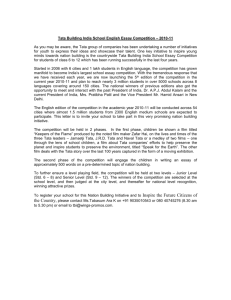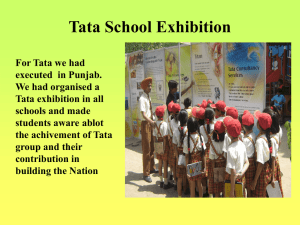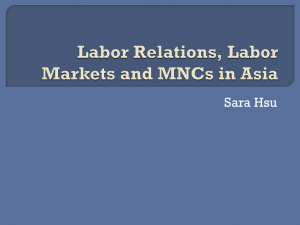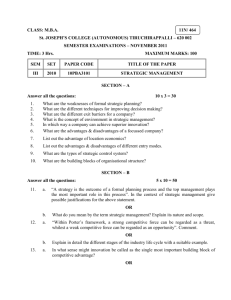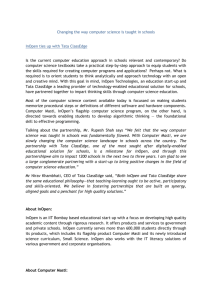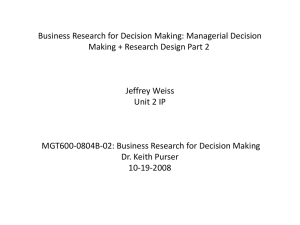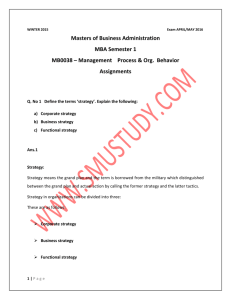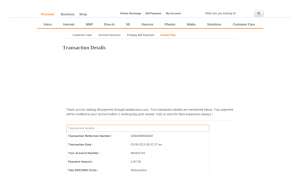Classification of Organisations Sumantra Ghoshal & Christopher A
advertisement
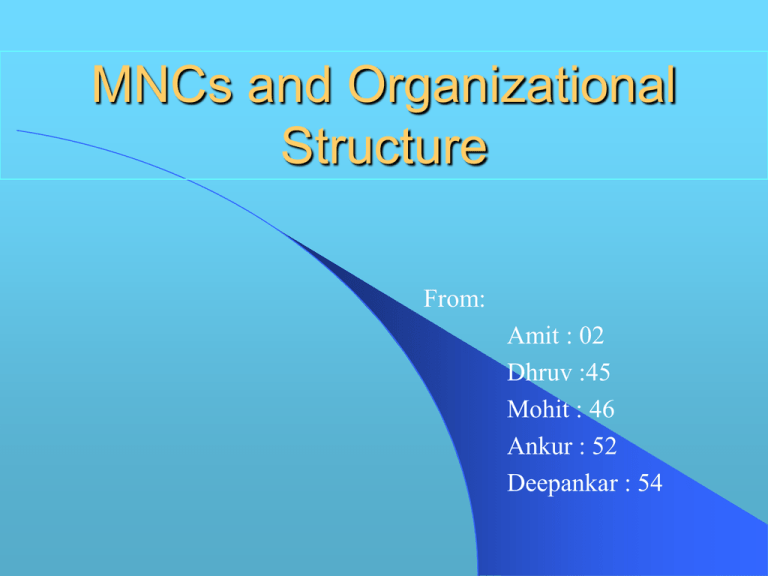
MNCs and Organizational Structure From: Amit : 02 Dhruv :45 Mohit : 46 Ankur : 52 Deepankar : 54 Defining Organizational Structure organizational structure the formal framework by which job tasks are divided, grouped and coordinated. organizational structural designing - process of developing or changing an organization’s structure. There is no permanent organization chart for the world. . . . It is of supreme importance to be ready at all times to take advantage of new opportunities. - Robert C. Goizueta, (Former) Chairman and Ceo, Coca-Cola Company Evolution and Change in MNC Internationalization is the process by which a firm gradually changes in response to international competition, domestic market saturation, and the desire for expansion, new markets, and diversification. Structural Evolution occurs when managers redesign the organizational structure to optimize the strategy’s changes to work, making changes in the firm’s tasks and relationships and designating authority, responsibility, lines of communication, geographic dispersal of units and so forth Six key elements : Work Specialization – the degree to which tasks in an organization are divided into separate jobs • individuals specialize in doing part of an activity rather than the entire activity – too much specialization has created human diseconomies – an important organizing mechanism, though not source of ever-increasing productivity Departmentalization – the basis by which jobs are grouped together • functional - groups jobs by functions performed • product - groups jobs by product line • geographical - groups jobs on the basis of territory or geography • process - groups jobs on the basis of product or customer flow • customer - groups jobs on the basis of common customers Span of Control – number of employees that a manager can efficiently and effectively manage – determines the number of levels and managers in an organization – the wider the span, the more efficient the organization – appropriate span influenced by: • the skills and abilities of employees • the complexity of tasks performed • availability of standardized procedures • sophistication of organization’s information system Centralization – the degree to which decision making is concentrated at a single point in the organization • top-level managers make decisions with little input from subordinates in a centralized organization Decentralization – the degree to which decisions are made by lower level employees – distinct trend toward decentralized decision making Formalization – the degree to which jobs within the organization are standardized • standardization - removes the need for employees to consider alternatives – extent to which employee behavior is guided by rules and procedures • employee allowed minimal discretion in highly formalized jobs – explicit job descriptions – clearly defined procedures ORGANISATIONAL STRUCTURES International Division Structure Chief Executive Officer Production Domestic Division Paint Marketing Domestic Division Tools Personnel Finance International Division Domestic Division Furniture Japan Australia Italy Office Operations Marketing Government Relations Domestic Division Hardware 11 Matrix Organisational Structure PRESIDENT Director of Product Design Product Manager A Product Manager B Product Manager C Product Manager D Manufacturing VP Marketing VP Controller Procurement Manager FUNCTIONAL STRUCTURE PRESIDENT VICE PRESIDENT MARKETING MARKETING RESEARCH VICE PRESIDENT ENGG. SALES VICE PRESIDENT FINANCE RECORDS VICE PRESIDENT MANUF. SHIPPING & RECIEVING PLANT1 RESEARCH GROUPS SALES FORCE VICE PRESIDENT PERSONNEL PRODUCTION PLANT2 VICE PRESIDENT LEGAL AFF QUALTIY ASSURANCE PLANT3 RECORD CLERKS 13 Strategic Business Unit The idea was developed by Mckinsey & Co. (Consulting Firm) & General Electric in 1971. Separate operating entities within an organization. After defining mission, a company establishes SBU’s which is self contained division, product line or product department within an organization. To be identified an SBU, an entity should, Be a separate identifiable business Have a distinct mission Have its own competitors Have its own executive group with profit responsibility General Electric & its SBU’s are electrical motors, Major appliances, Jet Engines Lighting Equipments and Commercial Credit and Broadcasting. 14 Classification of Organizations Sumantra Ghoshal & Christopher A. Bartlett The Study…. 3 countries 3 industries 9 companies with worldwide interests Mode : Both personal interviews and survey questionnaires of key personnel. Aim : To develop a typology of organizations operating in the international business environment. 16 Based on their results, these scholars identified four forms of organizations used to manage international businesses. They labeled these the multinational, global, international, & transnational corporations. 17 The story so far………. Multinational Enterprise Strategic competency Structures Responsiveness Loose federations of enterprises; National subsidiaries solve all operative tasks and some strategical. Decentralized federation Global Enterprise International Enterprise Efficiency Transfer of learning National Subsidiaries primarily seen as distribution centers; all strategic and Many operative Decisions centralized Tightly centralized hub; Somewhere in between multinational and global enterprises; some strategic areas centralized, some Decentralized Coordinated federation 18 ….and the problem Multinational enterprise : Differentiation as primary way to enhance performance. Global enterprise : Scale and resulting cost leadership are the key sources of competitive advantage. International enterprises : Innovation, Crated at HQ to reduce cost or increases revenue or both. Each approach is partially true and has its own merits but none represents whole truth, the ideal-type thus created, they dubbed the transnational enterprise. 19 Attributes of Transnational Enterprise. Selective decision, complex configuration of assets and capabilities that are distributed, yet specialized. Seeks efficiency not for its own but…, It acknowledges the importance of local responsiveness but…, Innovations are regarded as an outcome of a larger process of organization learning that encompasses every member of the company. 20 This thesis is thus consistent with the view that a new, stateless corporate identity with a network of systems and activities in different parts of the world, deriving value from whichever location provides it at the lowest cost, is emerging. (cf. Hedlund |1986~; Perlmutter and Trist |1986~; Prahalad and Doz |1987~). 21 CASE STUDIES TATA GROUP (INDIAN CASE) CATERPILLAR (FOREIGN CASE) 22 INDIAN BUSINESS HOUSES TATA GROUP Group Overview Metals Automobiles India’s largest business house Energy More than 85 companies Engineering 39 listed Chemicals 8% of India’s market capitalization Pharmaceuticals 2.6 Million shareholders IT and Communication 2,70,000 employees Exports Turnover Rs 343 billion (1996-1997) Finance INDIAN BUSINESS HOUSES TATA GROUP Tata Heritage Jamsetji Tata – Started textile mill in 1877 – Inspired steel and power industry – Technical education and philanthropy JRD Tata – Pioneered civil aviation – Funded Hom Bhabha’s nuclear programme – Guided the Tata group for over half a century Ratan Tata – Present Chairman since 1991 HOLDING COMPANIES Tata Sons – Founded by Jamsetji Tata – Promoted many of the present Tata companies – 63% held by Tata philanthropic trusts Tata Industries – 100% subsidiary of Tata Sons founded in 1945 – Managing agency till 1970 – Promoted new Tata companies in technology based businesses Cross holdings among other Tata companies INDIAN BUSINESS HOUSES TATA GROUP Restructuring • Prompted by post 1991 changing environment • Need to identify and focus on core businesses • Resistance from satraps – Russi Mody, Darbari Seth, Ajit Kerkar • Shrink number of companies – From over 85 to about 30 • Shrink number of core businesses – From about 25 to around 10 or 12 • Mergers and divestments • McKinsey hired as a consultants RESTRUCTURING STRATEGIES Keep and grow – Power, watches, metals, chemicals, telecom, hospitality, financial services, infotech, emerging services, infrastructure, automobiles Forge strategic tie ups – Tea and beverages, retailing Remain only as strategic investors – Luxury cars, infotech, printing, cosmetics Sell – Refrigeration, paints, textiles, trading, electronics, oil drilling, petrochemicals, pharma, specialty chemicals AUTOMOTIVE CHALLENGES Accelerating product introductions Rapidly implementing changes Improving time-to-market Tightening Regulatory requirements Efficiently transferring processes and best practices More innovations STRATEGIES ADOPTED To meet these challenges, the TATA adjust their product development as follows: – Reducing the period of development – Optimizing the in-house capabilities – Modularizing the product – Increasing the number of products/ variants – Improving product performance i.e. Durability, NVH, Safety, and Ride quality Some of the steps connected to these strategies are – Introduction of new working methods (Simultaneous Engineering, Concurrent Engineering, use of NPI process) – Usage of highly sophisticated functions of CAD systems (Parametric, Feature based Design, Digital Mock Up) – Early concept evaluation (Computation and Simulation) 30 CATERPILLAR Peoria, Illinois Highly Centralized before 1970 Blessings from Home!! Japanese and European Rivals – Hands-on Decisions Traditional Structure Engineering Manufacturing Finance Marketing Accounting Change in Stance Huge Loses in International Market Share 1985s Marketing Division International Division 1/3(1970) 1/5(1988) Market Gap Market Growth (By 1990) 32 nd 2 Change in Stance 1990 - 1995 - 2000 Caterpillar Financial Services, Tennessee Capital Asset Underwriting of Global Business Organization Redefined (….2000) Functional Divisions Essential Administrative Centers for Accounting, Legal and Regulatory Affairs and various Executive Support Systems 33 CATERPILLAR Functional Divisions 13 Profit Centers 1997 16 Integrated Profit Centers 4 Service Centers 1997 5 Global Service Centers Wheel Loaders and Excavators Division(WLED) • Tractor Dept + Heavy Equipment • Further branched acc. to customer groups such as mining(full P n L responsibility) 34 Gains Focus on Design, Manu., Procurement, Distribution, Service Strengthened Foreign Subsidiaries and Dealerships Customers contacts under local control Do away with International Division NEW WAY OLD WAY Customer Cross Border Customer Alliance Office/Dealership Places order to Illinois Shipping Financing Available (through Company’s Subsidiary) Financing through US Institutions 35 Each division – CFT Also part of Global Network PROPRIETERY Caterpillar Parts or Free to OUTSOURCE Profits more, up by 20%, 1996 24% growth in net income,1997 Heavy investments for repositioning International Division with restructured subsidiaries, Foreign Sales improved considerably R&D across border to supplement Illinois R&D center “ BORDERLESS ORGANIZATION” 36 THANKS 37
